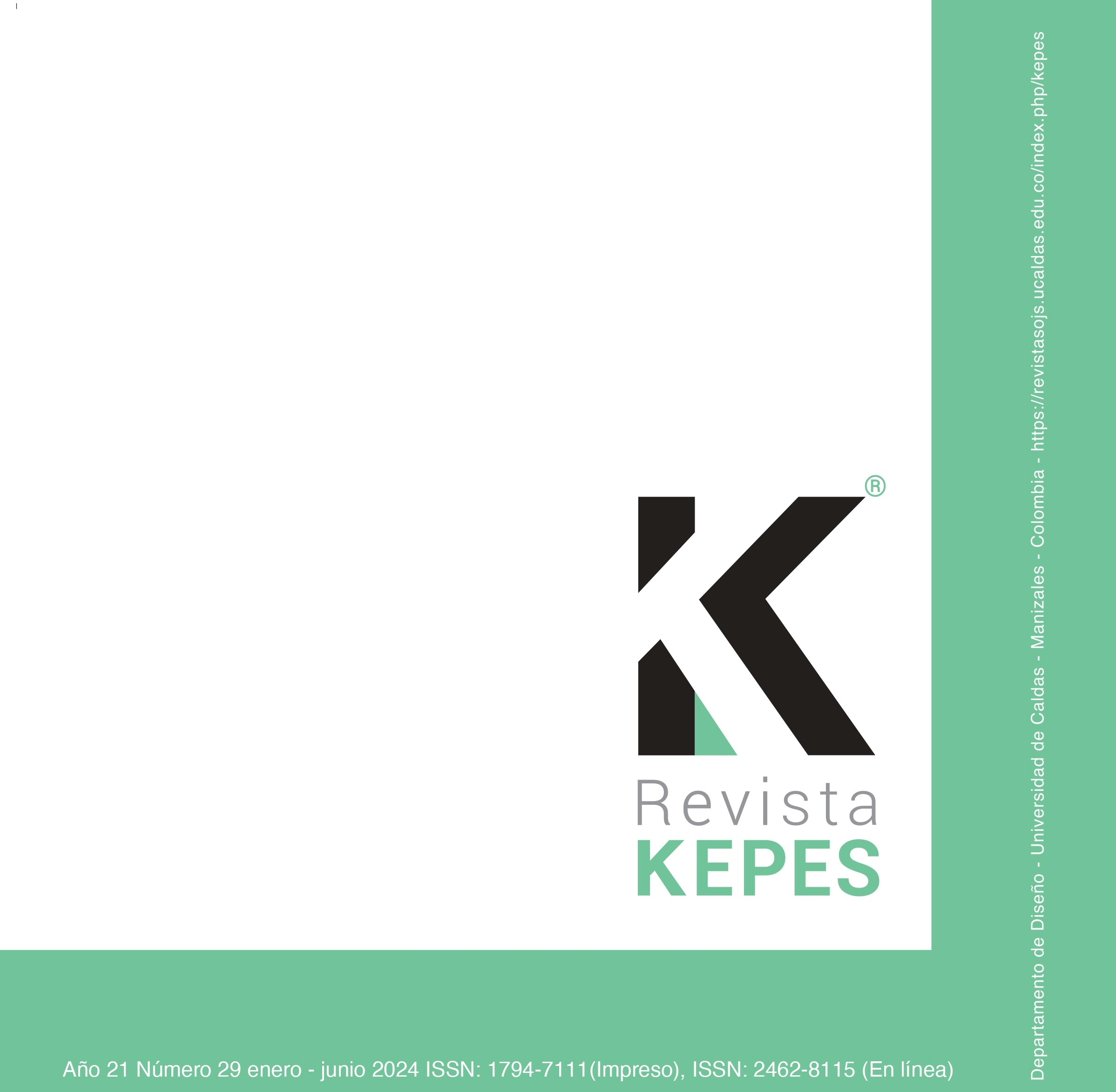Autores/as
Resumen
En este artículo, analizaremos más de cerca el objeto ‘trastienda’ de la cocina, que contiene las herramientas necesarias para una preparación eficaz de los alimentos. Se trata de objetos que normalmente son invisibles para los invitados, pero también, como demostraremos, para el discurso del diseño. Un objeto que ilustra la función de los utensilios de cocina es una herramienta para lavar el arroz antes de cocinarlo: Lavarroz de la dentista brasileña Therezinha Beatriz Alves de Andrade Zorowich. Esta herramienta forma parte del equipamiento estándar de las cocinas brasileñas (y no sólo) desde 1959. Analizaremos la importancia de Lavarroz y herramientas similares en un contexto social, incluso en el contexto de la cultura y la historia. Mostraremos las diferencias en
la comunicación social utilizando vajillas y utensilios de cocina comparando las características de los objetos y la comunicación mediática que los compaña. Consideraremos cuán profundas están en la cultura las raíces del desprecio por los platos y los utensilios de cocina. También hubo períodos y lugares en la historia donde las herramientas de la parte trasera de la cocina fueron el centro de atención. ¿Qué condiciones debían cumplirse para que los utensilios de cocina aparecieran en el museo? También intentaremos responder a la pregunta de por qué en el discurso público se llama a Lavarroz un ‘invento’ y no un ‘proyecto’.
Palabras clave
Citas
Adamson, G. (2018). Fewer, Better Things. The Hidden Wisdom of Objects. Bloomsbury Publishing.
Archer, S. (2019, May 8). The Frankfurt Kitchen Changed How We Cook—and Live. Bloomberg.com. https://www.bloomberg.com/news/articles/2019-05-08/the-frankfurt-kitchenchanged-how-we-cook-and-live
Anthropophagic Movement -. (2020, August 31). http://allthematters.com/literature/anthropophagic-movement/
Bandoni, A. (2019). The Digital Age Reaches the Fringes. A Public Fab Lab in Brazil and Its (Possible) Implications for Design. In M. van Halvert The Responsible Object. A History of Design Ideology for the Future (pp. 209-226). Valiz.
Bonsiepe, G. (2011). Reflections on a manifesto for design education 2011. http://www.guibonsiepe.com/wp-content/uploads/2019/04/Manifesto_design_2011_03_10_final.pdf
Bourdieu, P. (1984). Distinction. A Social Critique of the Judgement of Taste. Harvard University Press.
Brukalska, B. (2029). Kuchnia współczesna. Dom, Osiedle, Mieszkanie (1) 1929, 8-11. Caldatto, A. Fundação Brinquedos Trol S/A Indústria e Comércio. (2015). https://anacaldatto.blogspot.com/2015/01/fundacao-trol-sa-industria-e-comercio.html
Criado-Perez C. (2020). Niewidzialne kobiety: Jak dane tworzą świat skrojony pod mężczyzn.Karakter.
De Batatais para o mundo. (n.d.). Revista Piauí. https://piaui.folha.uol.com.br/materia/debatatais-para-o-mundo/de Andrade, O., & Bary, L. (1991). Cannibalist Manifesto. Latin American Literary Review, 19(38), 38–47. https://www.jstor.org/stable/20119601?origin=JSTOR-pdf
De Bondt. S., (2014). Graphic Design history in the writing (1983-2011). Occasional Papers. Draper J., Fialkowski Revilla M., K., & Titchenal A. (2020). Introduction to Carbohydrates. Medicine LibreTexts. https://med.libretexts.org/Bookshelves/Nutrition/Human_Nutrition_2020e_Hawaii)/04%3A_Carbohydrates/4.01%3A_Introduction#:~:text=In%20ancient%20Hawai
Edgerton, D. (2019). The Shock of the Old: Technology and Global History Since 1900. Profile Books.
Estudio Campana for Edra, Favela Wooden Chair, Brazillian Design. (n.d.). 1stDibs.com.
https://www.1stdibs.com/en-gb/furniture/seating/chairs/estudio-campana-edra-favela-woddenchair-brazillian-design/id-f_32484382/?modal=intlWelcomeModal
Czerwiński, T. (2009). Wyposażenie domu wiejskiego w Polsce. Muza.
Face the Nation. (2017 June 1). Nikita Khrushchev on Face the Nation in 1957 [Video]. YouTube.https://www.youtube.com/watch?v=XAG6D73gttA
Guidot, R. (1998). Design 1940-1990. Wzornictwo i Projektowanie. Arkady.
Göransdotter, M., Redström, J. (2018, Spring) Design Methods and Critical Historiography: An Example from Swedish User-Centered Design, Design Issues, Vol. 34, No. 2, 20-30.
Groys, B. (2014). On Art Activism. E-flux. https://www.e-flux.com/journal/56/60343/on-artactivism/
Fartura. (2022). Você sabia que o escorredor de arroz foi inventado por uma brasileira? Fartura. Gastronomia do Brasil. https://www.farturabrasil.com.br/curiosidades/voce-sabia-que-oescorredor-de-arroz-foi-inventado-por-uma-brasileira/
Fiell, Ch. & Fiell, P. (2002). Skandinavischens Design. Taschen.Frejlich, Cz., Dizajnerki. Barbara Brukalska, Formy Magazine. https://formy.xyz/krotka-forma/dizajnerki-barbara-brukalska/
Ilstedt Hjelm, S. (2002) Semiotics in product design. CID–175 (Centre For User Oriented IT Design). https://www.researchgate.net/publication/238458122_Semiotics_in_product_design
Jackson, S. (2002, Autumn) The ‘Stump-Jumpers:’ National Identity and the Mythology of Australian Industrial Design in the Period 1930-1975. Design Issues. Vol. 18, No. 4, 14-23.
Kay, E. (2017). Vintage Kitchenalia. Amberley Publishing.
Kimmelman, M. (2019). Celebrating ‘Good Design’ at MoMA: The Nut Dish and Other Populist Gems. https://www.nytimes.com/2019/06/06/arts/design/moma-good-design.html
Larner, J., W. (1986, Summer) Judging the Kitchen Debate. OAH Magazine of History, Vol. 2, 25- 27. https://www.jstor.org/stable/25162497
Lupton, E. (1993). Mechanical Brides. Women and Machines from Home to Office. Cooper-Hewitt.
Lupton, E. (1996). Power Tool for Dining Room: The Electric Carving Knife. In B. Highmore,(2009). The Design Culture Reader (pp. 125-131). Routledge.
Lupton, E. & Miller, J., A. (1996)The Bathroom, The Kitchen, and the Aesthetics of Waste: a Process of Elimination, KIOSK.
Martínez, J., G. (2016). Design and national identity. Bloomsbury Academic.
Mendonça, F. (2015) 5 inventos que talvez você não saiba que são brasileiros. https://administradores.com.br/noticias/5-inventos-que-talvez-voce-nao-saiba-que-sao-brasileiros
Mesquita, O. (2014). Olivia’s Cuisine, from https://www.oliviascuisine.com/how-to-cook-rice
MoMA. (1938). Press release. https://www.moma.org/calendar/exhibitions/2745
MoMA. (1940). Useful Objects of American Design under $10: Democracy in Design Shown in Exhibition of Useful Objects at Museum of Modern Art. www.moma.org/documents/moma_pressrelease_325201.pdf
MoMA. (1943). Useful Objects In Wartime Fifth Annual Exhibition Of Useful Objects Under $10.00, The Bulletin Of The Museum Of Modern Art 2 Volume X December 1942–January 1943.
MoMA. (1951). For release June 22 June 1951 ‘Good Design’ exhibition to open during first market week, In News from Good Design. https://www.moma.org/momaorg/shared/pdfs/docs/press_archives/1522/releases/MOMA_1951_0040.pdf
Morelli Abrahão E. (2022). Recipes in Paulista Cuisine, Brazil (19th and 20th Centuries).[Conference presentation]. Food and Movement. Dublin Gastronomy Symposium.
Newson, A., Suggett, E., & Sudjic, D. (2016). Designer Maker User. Phaidon.
Papanek, V. (1985). Design for the real world. Thames & Hudson.
Professora Pardal. (n.d.). Netleland.net. http://netleland.net/hsampa/ppardal/
Sudjic D. (2015). B is for Bauhaus: an A-Z of the modern world. Penguin Books.The Kitchen Debate. Transcript, 24 July 1959, Vice President Richard Nixon and Soviet Premier Nikita Khrushchev. https://www.cia.gov/readingroom/docs/1959-07-24.pdf The Value of Good Design | MoMA. (n.d.). The Museum of Modern Art. https://www.moma.org/calendar/exhibitions/5032
Cooper Hewitt. (2014). Tools: Extending our Reach. Cooper Hewitt. Smithsonian Design Museum.
Treska-Siwoń, A. (2022). Projektant i użytkownik. Copernicus Center Press.
Von Seckendorff, E. (2013). “We’ll throw out the gold and silversmith shops and install a Plastics Workshop!”. Rinker, D., Quijano, M., & Reinhardt, B. (2003). ulmer modelle–modelle nach ulm / hochschule für gestaltung 1953-1968. Hatje Cantz Verlag.

 PDF
PDF
 FLIP
FLIP























